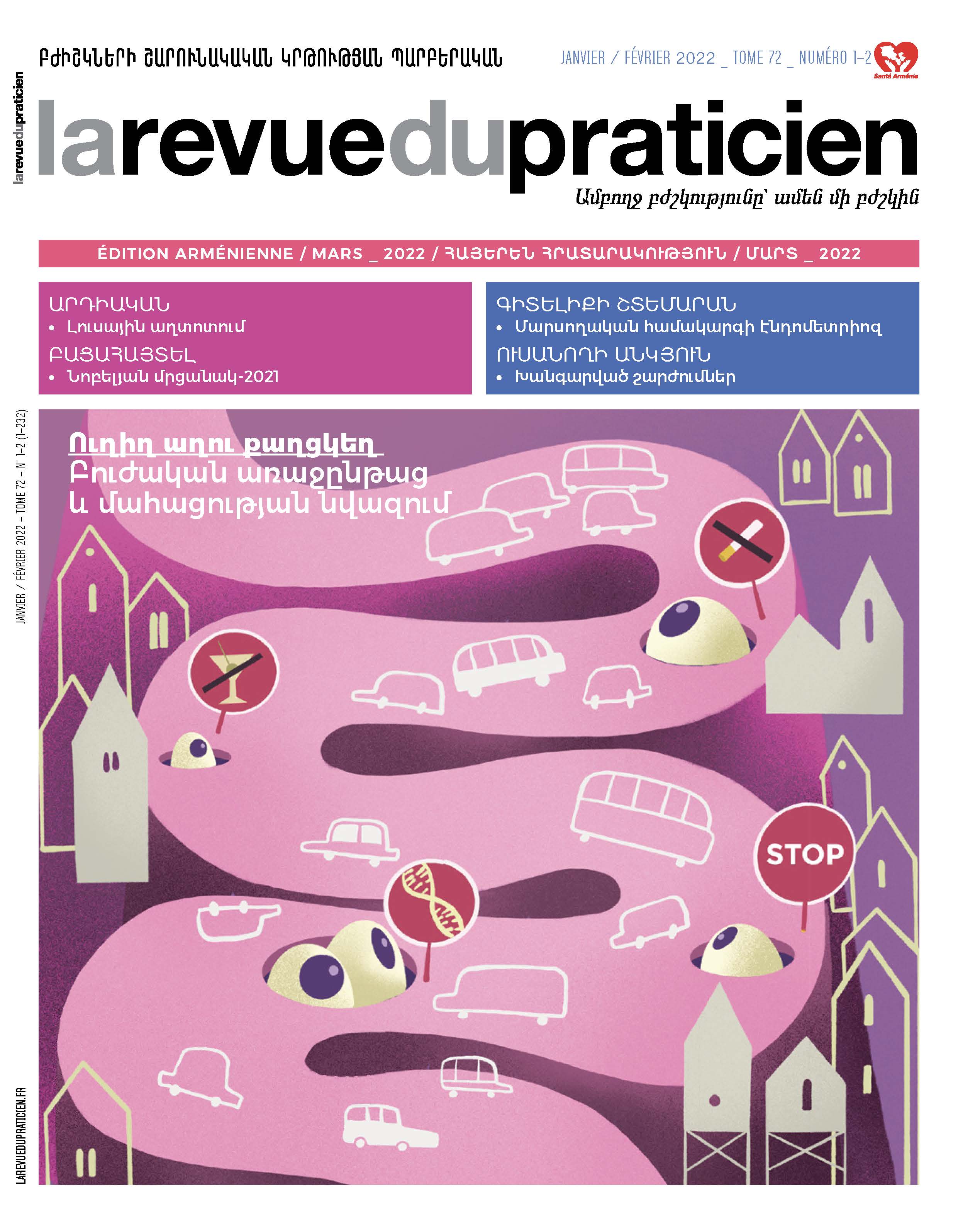Ամփոփագիր
Արհեստական լույսը կարող է վնասակար աղտոտիչ լինել ցանցաթաղանթի համար տեսանելի սպեկտրի (380-700 նմ)՝ մասնավորապես լուսարձակող դիոդներում (LED) կիրառվող կապույտ շերտի (380-500 նմ) թունավոր ազդեցության պատճառով: Լուսաթունավորումն ի հայտ է գալիս ցանցաթաղանթի տեսողական գործառույթի համար պատասխանատու գունակային էպիթելի և լուսաընկալիչների լուսաքիմիական վնասման հետևանքով: Լուսաընկալիչների լուսազգայուն գունակները՝ օպսինները՝ շշիկների, ռոդոպսինները՝ ցուպիկների համար, օրվա ընթացքում սպառվում են, գիշերը՝ վերականգնվում: Գիշերային ժամերին լույսի ազդեցությունը մեծապես խաթարում է դրանց նյութափոխանակությունը: Լուսաթունավորությունը, ժառանգականության հետ մեկտեղ, ցանցաթաղանթի դեգեներատիվ հիվանդությունների առաջացման հիմնական գործոնն է, իսկ, բացի դրանցից, նաև տարիքի և ծխելու ազդեցությունը՝ առավել հաճախ հանդիպող դեղին բծի տարիքային դեգեներացիայի:
Գիշերային ժամերին արհեստական լույսի ազդեցությունը խաթարում է ներքին ժամացույցի աշխատանքը: Ցանցաթաղանթի ոչ տեսողական գործառույթների համար պատասխանատու՝ բնույթով լուսազգայուն հանգուցային բջիջները (ipRGC) ընկալում են լուսային ազդանշանը, որը հաղորդվում է ներքին ժամացույցին, ապա՝ հասնում կոնաձև գեղձին: Լույսն արգելակում է մելատոնինի արտազատումը և ապահամաժամանակեցման շրջանակում կարող է առաջ կամ հետ գցել ներքին ժամացույցը՝ կախված ազդեցության ժամից: Հերթափոխով և գիշերներն աշխատողները, ինչպես նաև դեռահասները ենթակա են արհեստական լույսի ազդեցությանը: Գիշերներն աշխատող բուժքույրերի շրջանում քաղցկեղով բարձր հիվանդացությունը պայմանավորված է մելատոնինի արտազատման արգելակմամբ, քնի պակասով և ապահամաժամանակեցմամբ: Էկրանների ազդեցությունը դեռահասների վրա նույնպես հարցեր է առաջացնում, քանի որ սարքերի լուսադիոդները ճառագայթում են կապույտ լույս, որը զգալի ազդեցություն ունի ներքին ժամացույցի վրա: Հերթափոխով աշխատողների, ինչպես նաև դեռահասների քրոնիկական ապահամաժամանակեցումը պետք է դիտարկվի որպես հանրային առողջապահության կարևոր հիմնախնդիր
Résumé
La lumière artificielle peut être un agent polluant délétère pour la rétine, en rapport avec la toxicité de la bande bleue (380-500 nm) du spectre visible (380-700 nm), notamment utilisée dans les diodes électroluminescentes (LED). La phototoxicité résulte de lésions photochimiques au niveau de l’épithélium pigmenté et des photorécepteurs rétiniens responsables de la fonction visuelle de la rétine. Leurs pigments photosensibles, opsines pour les cônes et rhodopsines pour les bâtonnets, sont consommés le jour et régénérés la nuit. L’exposition à la lumière la nuit perturbe gravement leur métabolisme. La phototoxicité constitue, avec l’hérédité, un facteur majeur pour les maladies dégénératives de la rétine avec, en plus, l’impact de l’âge et du tabac pour la plus fréquente d’entre elles, la dégénérescence maculaire liée à l’âge (DMLA). L’exposition à la lumière artificielle la nuit (LAN) dérègle l’horloge interne. Les cellules ganglionnaires intrinsèquement photosensibles (ipRGC), responsables des fonctions non visuelles de la rétine, perçoivent le signal lumineux qui est transmis à cette l’horloge interne pour aboutir à la glande pinéale. La lumière inhibe la sécrétion de mélatonine et est capable d’avancer ou de retarder l’horloge selon l’heure d’exposition, dans le cadre d’une désynchronisation. Les travailleurs postés et de nuit, comme les adolescents, sont exposés à la LAN. L’incidence de cancer du sein, plus élevée chez les infirmières exposées à la LAN, est attribuée à l’inhibition de la mélatonine, la privation de sommeil et la désynchronisation. L’exposition des adolescents aux écrans pose aussi question, car les diodes électroluminescentes (LED) des appareils émettent une lumière bleue dont l’impact sur l’horloge interne est considérable. Les désynchronisations chroniques des travailleurs postés, comme celles des adolescents, doivent être considérées comme des préoccupations importantes de santé publique.
Abstract
Artificial light can be a polluting agent deleterious for the retina, in relation to the toxicity of the blue band (380-500 nm) of the visible spectrum (380-700nm) specifically used in light-emitting diodes (LEDs). Photo-toxicity results from photochemical damage to the pigmented epithelium and retinal photoreceptors responsible for the visual function of the retina. Their photosensitive pigments, opsins for the cones and rhodopsin for the sticks, are consumed during the day and regenerated at night. Exposure to light at night seriously disrupts their metabolism. Photo-toxicity, along with heredity, is a major factor in degenerative diseases of the retina with, in addition to, the impact of age and tobacco for the most common of them, Age-related macular degeneration: ARMD. Exposure to artificial light at night (LAN) has a deleterious effect on the internal clock. Intrinsically photosensitive ganglion cells (ipRGCs) are responsible for the non-visual functions of the retina, and perceive the light signal that is transmitted to the internal clock to reach the pineal gland. Light inhibits the secretion of melatonin and is able to advance or delay the clock depending on the time of exposure, causing desynchronization. Shift and night workers, like teenagers, are exposed to LAN. The incidence of breast cancer, higher in nurses exposed to LAN, is related to melatonin inhibition, sleep deprivation and desynchronization. The exposure of adolescents to screens is also questionable because the LEDs of the devices emit a blue light, the impact of which on the clock is considerable. The chronic desynchronizations of both shiftworkers and adolescents should be considered a major public health concern.
